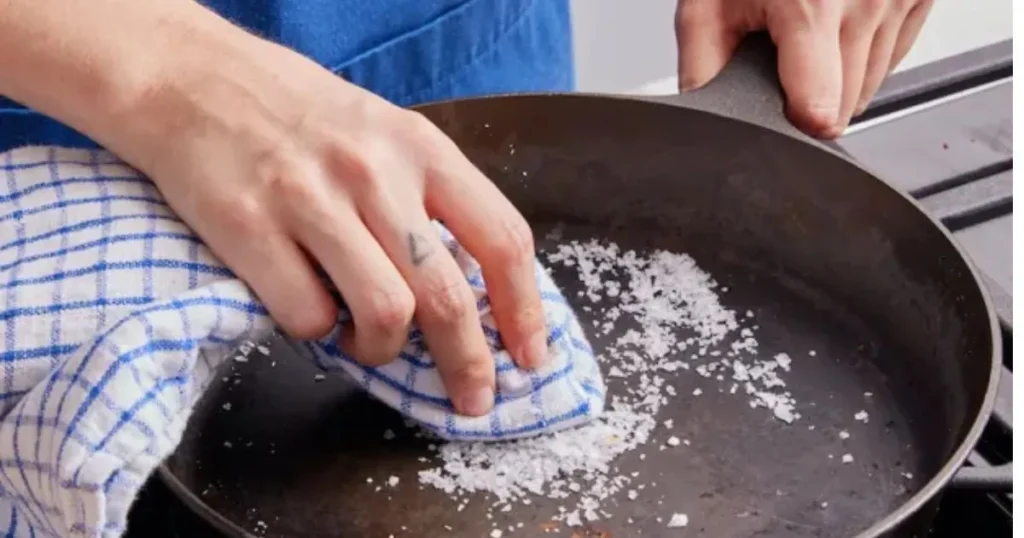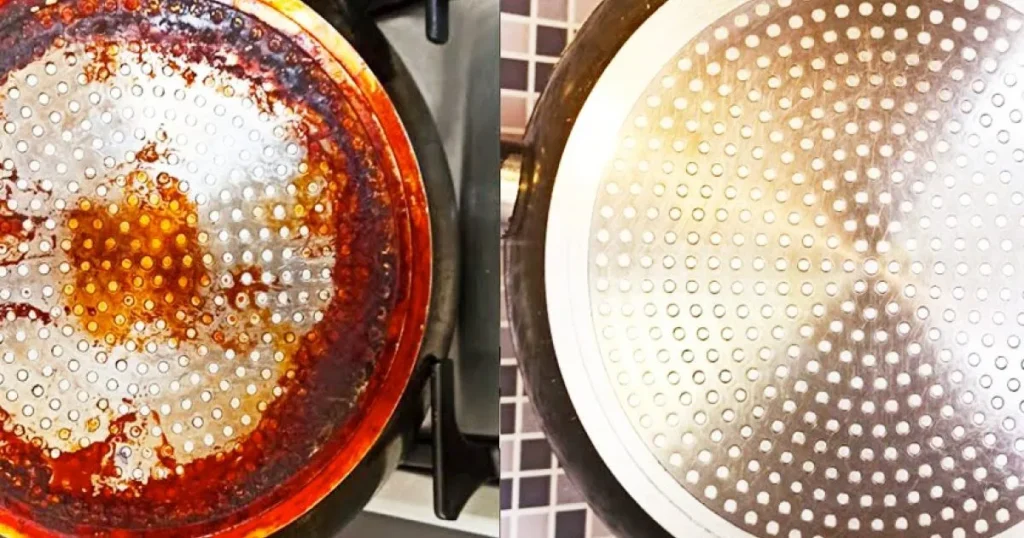Table of Contents
Get Rid of Grease Stuck in Your Pots and pans after cooking a delicious meal should be an easy task, but when grease gets stuck, it can feel like an impossible challenge. Whether it’s from a hearty stew, a crispy roast, or a simple frying session, grease can build up in layers, making your pots look like they’ve been through the wringer. But don’t fret—getting rid of grease stuck in your pots is easier than you think! In this guide, you’ll learn tried-and-tested methods, from simple home remedies to essential tools that will have your pots looking brand new again. tips
Why Get Rid of Grease Stuck in Your Pots?
Before jumping into the cleaning process, it’s important to understand why Get Rid of Grease Stuck in Your Pots in the first place. Grease often builds up when oils and fats used in cooking cling to the pot’s surface due to heat. Over time, this builds a layer that hardens and becomes difficult to remove. The type of cookware you use can also make a difference. For instance, cast iron and stainless steel pots tend to attract and hold onto grease more stubbornly than nonstick or enamel-coated pots.
The good news? There’s no need to throw away your pots or resort to harmful chemicals. There are a variety of natural cleaning methods that can work wonders, saving you time, money, and energy. Let’s dive into how you can effectively tackle that grease.

Essential Tools and Ingredients to Get Rid of Grease Stuck in Your Pots
Before you get started, make sure you have the right tools and ingredients at hand. These will help you clean your pots quickly and effectively without causing damage.
Cleaning Tools You’ll Need:
- Scrub Brushes: A gentle scrub brush helps dislodge grease without scratching delicate surfaces.
- Sponges: Both soft and abrasive sponges are essential. Use soft ones for nonstick surfaces and abrasive ones for stubborn grime on cast iron or stainless steel.
- Steel Wool Pads: Perfect for tough grease on stainless steel or cast iron, but be cautious—this can scratch some surfaces.
- Dishcloths & Microfiber Towels: These are great for wiping away residue after cleaning.
- Rubber Gloves: Protect your hands from harsh chemicals or prolonged exposure to hot water.
Best Natural Ingredients for Get Rid of Grease Stuck in Your Pots:
- Baking Soda: An effective natural scrubber that cuts through grease with ease.
- White Vinegar: Known for its degreasing power and ability to break down stubborn grease.
- Lemon Juice: Naturally acidic and perfect for cutting through grease, while leaving a fresh scent.
- Dish Soap: A simple yet effective tool for removing grease from any surface.
- Salt: Coarse salt works as an abrasive cleaner, especially for tough grease stains on cast iron pans.
- Olive Oil: Use olive oil to clean cast iron skillets without ruining the seasoning.
Step-by-Step Guide: How to Get Rid of Grease Stuck in Your Pots
Now that you’ve got the tools and ingredients ready, it’s time to get to work! Here’s a simple guide to help you get rid of that greasy residue.
Step 1: Soak Your Pots with Hot Water
The first step in loosening stuck grease is soaking your pots. Fill the pot with hot water and let it sit for about 10-15 minutes. Hot water will soften the grease, making it easier to scrub away. If the grease is particularly tough, add a few drops of dish soap to help break it down even further.
Pro Tip: For extremely greasy pots, add a small amount of white vinegar or lemon juice to the water. This helps dissolve the oils more effectively.
Step 2: Apply Natural Ingredients to Cut Through Grease
After soaking, it’s time to apply some powerful natural ingredients. Here are a few methods that work like a charm:
- Baking Soda Paste: Create a paste by mixing 1-2 tablespoons of baking soda with a little water. Apply the paste to the greasy areas and let it sit for 10-20 minutes. The baking soda will work to break down the grease, making it easier to scrub away.
- Vinegar and Baking Soda Reaction: Sprinkle a generous amount of baking soda directly onto the grease. Then pour a little vinegar over it. You’ll notice it fizzing up, which helps lift the grease. Let the reaction work for a few minutes before scrubbing.
- Lemon Juice: For a more natural method, squeeze some fresh lemon juice over the grease. Its acidity helps cut through oils and leaves your pots smelling fresh. Let it sit for 10 minutes before scrubbing.
Step 3: Scrub Away the Grease
Now comes the scrubbing part! Use your scrub brush or sponge to work on the grease. For stainless steel or cast iron, you can use a steel wool pad for stubborn spots, but make sure to scrub with the grain for stainless steel to avoid scratches. Always be gentle with nonstick cookware, as aggressive scrubbing can damage the coating.
Pro Tip: For cast iron pans, avoid using soap as it can strip the seasoning. Instead, use a coarse salt scrub and a bit of oil.
Step 4: Rinse and Dry Properly
Once the grease is gone, it’s time to rinse your pots thoroughly. Use warm water to remove any cleaning solution or residue. Dry your pots immediately with a towel to prevent water spots, rust, or any remaining moisture from sticking to the surface.
Specialized Tips for Different Types of Pots
Different pots require different cleaning techniques. Let’s take a closer look at how to treat each type.
How to Clean Grease from Cast Iron Pots
Cast iron is notorious for attracting grease. However, it’s also one of the most durable types of cookware when cared for properly. Here’s how to clean it:
- Avoid Soap: Soap can strip away the seasoning and damage the non-stick layer.
- Salt Scrub: Use coarse salt as a natural abrasive to scrub away grease.
- Re-Season: After cleaning, always re-season your cast iron with a thin layer of oil to maintain its non-stick properties.
Removing Grease from Stainless Steel Pots
Stainless steel pots tend to show grease more visibly, but they’re relatively easy to clean:
- Use Baking Soda and Vinegar: For tough grease spots, make a paste with baking soda and water and apply it directly to the grease.
- Steel Wool Pads: For stubborn grease, use a steel wool pad, but make sure to scrub with the grain to avoid scratching the surface.
Get Rid of Grease Stuck in Your Pots Without Damaging the Coating
Nonstick pans are easier to clean, but you need to be cautious not to damage the coating:
- Gentle Scrubbing: Always use soft sponges or microfiber cloths to avoid scratching the surface.
- Avoid Harsh Chemicals: Stick to natural cleaning methods like vinegar, baking soda, or lemon juice.
- Don’t Overheat: Excessive heat can damage the nonstick coating, so always clean it once it cools down.
Natural Alternatives to Chemical Cleaners for Get Rid of Grease Stuck in Your Pots
While store-bought degreasers may promise quick results, they often come with a host of chemicals that could damage your cookware or harm your health. Natural alternatives, on the other hand, are non-toxic and cost-effective.
Why Choose Natural Cleaners?
Natural cleaners like baking soda, vinegar, and lemon juice are not only better for your pots, but they’re also gentler on the environment. They don’t release harmful chemicals into the air or water and are often just as effective as commercial cleaners for removing grease.
DIY Grease Removal Recipe
Here’s a simple, DIY grease cleaner you can whip up with items you probably already have in your kitchen:
| Ingredient | Amount |
| Baking Soda | 1 tablespoon |
| Vinegar | 1 cup |
| Lemon Juice | 2 tablespoons |
| Hot Water | 2 cups |
Mix these ingredients into a paste or solution and apply it to the greasy areas of your pot. Let it sit for 15 minutes and scrub away.
Quick Fixes for Last-Minute Get Rid of Grease Stuck in Your Pots
Sometimes, you don’t have time for a full cleaning session. Here are a couple of quick fixes to help you out when you’re in a rush:
Fast Soak Method
Fill your pot with hot water and a few drops of dish soap. Let it sit for 5-10 minutes to loosen the grease. This method is great for cleaning pots after a quick meal.
Spot Treatment for Small Grease Spots
If you notice a small grease spot, dab a microfiber cloth with vinegar or lemon juice and gently rub it onto the spot. This method works well for nonstick pans and stainless steel cookware.
Common Mistakes to Avoid When Cleaning Grease
Cleaning grease can be tricky, especially when you’re using the wrong methods. Here are some common mistakes to avoid:
Overusing Harsh Chemicals
Harsh chemical cleaners can damage your pots and be harmful to your health. Stick to natural methods or use store-bought cleaners sparingly.
Scrubbing Too Hard
Aggressive scrubbing can scratch or damage your cookware. Always use the right type of sponge or brush for the material of your pots.
Neglecting to Dry Properly
Leaving water on your pots can lead to rust or water spots. Always dry your pots immediately after cleaning.

Conclusion: Enjoy Clean, Get Rid of Grease Stuck in Your Pots-Free Pots Every Time
With the right tools, ingredients, and techniques, getting rid of grease stuck in your pots is easier than you think. Whether you’re dealing with cast iron, stainless steel, or nonstick cookware, these cleaning methods will help you restore your pots to their original shine. Plus, using natural cleaners ensures your pots last longer while keeping your kitchen environment safe and chemical-free.
So, the next time you’re faced with a greasy pot, remember these tips and tricks. With a little time and effort, you’ll have your cookware looking as good as new—no more stubborn grease in sight!
FAQ: How to Effectively Get Rid of Grease Stuck in Your Pots
Q1: How can I prevent grease from building up in my pots?
A1: To prevent grease from sticking, avoid using too much oil when cooking and make sure to clean your pots immediately after use.
Q2: What’s the best method for getting rid of grease in a cast iron pot?
A2: Use coarse salt and oil to scrub the grease off. Re-season your cast iron pot after cleaning to keep it in good condition.
Q3: Can I use store-bought degreasers on my pots?
A3: Yes, but natural cleaners like vinegar and baking soda are often safer and more effective.
Q4: How often should I clean my pots to prevent grease build-up?
A4: It’s best to clean your pots after each use to prevent grease from hardening and becoming difficult to remove.
Q5: Can I use these methods for nonstick pots?
A5: Yes, but make sure to use non-abrasive sponges to protect the nonstick coating.

